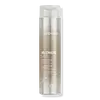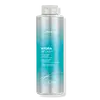What's inside
What's inside
 Key Ingredients
Key Ingredients

No key ingredients
 Benefits
Benefits

 Concerns
Concerns

 Ingredients Side-by-side
Ingredients Side-by-side

Water
Skin ConditioningSodium C14-16 Olefin Sulfonate
CleansingIsopropylamine Dodecylbenzenesulfonate
CleansingCocamide Mipa
EmulsifyingDecyl Glucoside
CleansingGlycol Stearate
EmollientGlyceryl Caprylate/Caprate
EmollientPhenoxyethanol
PreservativeCalophyllum Inophyllum Seed Oil
AntimicrobialCocos Nucifera Oil
MaskingArginine Hcl
Skin ConditioningHydrolyzed Keratin
HumectantLaurdimonium Hydroxypropyl Hydrolyzed Keratin
Skin ConditioningRosa Canina Fruit Oil
EmollientGardenia Taitensis Flower Extract
Skin ConditioningSorbitol
HumectantDivinyldimethicone/Dimethicone Copolymer
Phosphatidylcholine
EmulsifyingBis-Cetearyl Amodimethicone
Polyquaternium-10
PEG-150 Distearate
EmulsifyingSilicone Quaternium-16
Skin ConditioningAmodimethicone
Tetrasodium Glutamate Diacetate
PEG-90m
Emulsion StabilisingC12-13 Pareth-23
CleansingC12-13 Pareth-3
EmulsifyingCitric Acid
BufferingUndeceth-11
EmollientCeteareth-25
CleansingCeteareth-7
EmulsifyingC11-15 Pareth-7
EmulsifyingTrideceth-12
EmulsifyingGlycerin
HumectantLaureth-9
EmulsifyingUndeceth-5
EmulsifyingButyloctanol
HumectantPEG-4 Laurate
EmulsifyingIodopropynyl Butylcarbamate
PreservativeSodium Hydroxide
BufferingButylphenyl Methylpropional
PerfumingLimonene
PerfumingGeraniol
PerfumingParfum
MaskingWater, Sodium C14-16 Olefin Sulfonate, Isopropylamine Dodecylbenzenesulfonate, Cocamide Mipa, Decyl Glucoside, Glycol Stearate, Glyceryl Caprylate/Caprate, Phenoxyethanol, Calophyllum Inophyllum Seed Oil, Cocos Nucifera Oil, Arginine Hcl, Hydrolyzed Keratin, Laurdimonium Hydroxypropyl Hydrolyzed Keratin, Rosa Canina Fruit Oil, Gardenia Taitensis Flower Extract, Sorbitol, Divinyldimethicone/Dimethicone Copolymer, Phosphatidylcholine, Bis-Cetearyl Amodimethicone, Polyquaternium-10, PEG-150 Distearate, Silicone Quaternium-16, Amodimethicone, Tetrasodium Glutamate Diacetate, PEG-90m, C12-13 Pareth-23, C12-13 Pareth-3, Citric Acid, Undeceth-11, Ceteareth-25, Ceteareth-7, C11-15 Pareth-7, Trideceth-12, Glycerin, Laureth-9, Undeceth-5, Butyloctanol, PEG-4 Laurate, Iodopropynyl Butylcarbamate, Sodium Hydroxide, Butylphenyl Methylpropional, Limonene, Geraniol, Parfum
Water
Skin ConditioningSodium Laureth Sulfate
CleansingCocamide Mipa
EmulsifyingDisodium Cocoamphodiacetate
CleansingGlycol Stearate
EmollientSodium Chloride
MaskingButyrospermum Parkii Butter
Skin ConditioningLaurdimonium Hydroxypropyl Hydrolyzed Keratin
Skin ConditioningArginine Hcl
Skin ConditioningPhosphatidylcholine
EmulsifyingRosa Canina Fruit Oil
EmollientCocos Nucifera Oil
MaskingHydrolyzed Algin
Sea Water
HumectantChlorella Vulgaris Extract
Skin ConditioningSodium Cetearyl Sulfate
CleansingCocamidopropyl Betaine
CleansingGuar Hydroxypropyltrimonium Chloride
Skin ConditioningCetyl Alcohol
EmollientAcrylates/Aminoacrylates/C10-30 Alkyl PEG-20 Itaconate Copolymer
Emulsion StabilisingDimethicone
EmollientSodium Citrate
BufferingCitric Acid
BufferingPEG-4 Laurate
EmulsifyingDisodium EDTA
Polyquaternium-7
DMDM Hydantoin
PreservativeIodopropynyl Butylcarbamate
PreservativeSodium Benzoate
MaskingMethylchloroisothiazolinone
PreservativeMethylisothiazolinone
PreservativePhenoxyethanol
PreservativePotassium Sorbate
PreservativeLinalool
PerfumingLimonene
PerfumingParfum
MaskingCI 42090
Cosmetic ColorantCI 60730
Cosmetic ColorantCI 19140
Cosmetic ColorantWater, Sodium Laureth Sulfate, Cocamide Mipa, Disodium Cocoamphodiacetate, Glycol Stearate, Sodium Chloride, Butyrospermum Parkii Butter, Laurdimonium Hydroxypropyl Hydrolyzed Keratin, Arginine Hcl, Phosphatidylcholine, Rosa Canina Fruit Oil, Cocos Nucifera Oil, Hydrolyzed Algin, Sea Water, Chlorella Vulgaris Extract, Sodium Cetearyl Sulfate, Cocamidopropyl Betaine, Guar Hydroxypropyltrimonium Chloride, Cetyl Alcohol, Acrylates/Aminoacrylates/C10-30 Alkyl PEG-20 Itaconate Copolymer, Dimethicone, Sodium Citrate, Citric Acid, PEG-4 Laurate, Disodium EDTA, Polyquaternium-7, DMDM Hydantoin, Iodopropynyl Butylcarbamate, Sodium Benzoate, Methylchloroisothiazolinone, Methylisothiazolinone, Phenoxyethanol, Potassium Sorbate, Linalool, Limonene, Parfum, CI 42090, CI 60730, CI 19140
Ingredients Explained
These ingredients are found in both products.
Ingredients higher up in an ingredient list are typically present in a larger amount.
We don't have a description for Arginine Hcl yet.
Citric Acid is an alpha hydroxy acid (AHA) naturally found in citrus fruits like oranges, lemons, and limes.
Like other AHAs, citric acid can exfoliate skin by breaking down the bonds that hold dead skin cells together. This helps reveal smoother and brighter skin underneath.
However, this exfoliating effect only happens at high concentrations (20%) which can be hard to find in cosmetic products.
Due to this, citric acid is usually included in small amounts as a pH adjuster. This helps keep products slightly more acidic and compatible with skin's natural pH.
In skincare formulas, citric acid can:
While it can provide some skin benefits, research shows lactic acid and glycolic acid are generally more effective and less irritating exfoliants.
Most citric acid used in skincare today is made by fermenting sugars (usually from molasses). This synthetic version is identical to the natural citrus form but easier to stabilize and use in formulations.
Read more about some other popular AHA's here:
Learn more about Citric AcidWe don't have a description for Cocamide Mipa yet.
Cocos Nucifera Oil is obtained from the kernels of the coconut fruit. In other words, this is coconut oil.
Coconut Oil is rich in fatty acids with lauric acid making up the majority of these. It also contains linoleic acid. Due to this high fatty acid content, coconut oil helps trap moisture and soften skin.
Despite being antibacterial, coconut oil may not be great for acne-prone skin. It is comedogenic and may clog pores. This ingredient may not be safe for malassezia or fungal acne.
Note: Coconut Oil should not replace your sunscreen for UV protection. Studies show it only blocks about 20% of UV.
This oil is non-volatile and has a light scent.
The term 'fragrance' is not regulated in many countries. In many cases, it is up to the brand to define this term. For instance, many brands choose to label themselves as "fragrance-free" because they are not using synthetic fragrances. However, their products may still contain ingredients such as essential oils that are considered a fragrance.
Learn more about Cocos Nucifera OilGlycol Stearate comes from stearic acid and ethylene glycol.
It is a creamy wax used to stabilize ingredients as an emulsifier. Glycol stearate also contains emollient properties. Emollients sit on top of the skin to prevent moisture from escaping.
This ingredient may not be Malassezia folliculitis, or fungal-acne safe.
Learn more about Glycol StearateIodopropynyl Butylcarbamate is a preservative.
We don't have a description for Laurdimonium Hydroxypropyl Hydrolyzed Keratin yet.
Limonene is a fragrance that adds scent and taste to a formulation.
It's found in the peel oil of citrus fruits and other plants such as lavender and eucalyptus. The scent of limonene is generally described as "sweet citrus".
Limonene acts as an antioxidant, meaning it helps neutralize free radicals.
When exposed to air, oxidized limonene may sensitize the skin. Because of this, limonene is often avoided by people with sensitive skin.
The term 'fragrance' is not regulated in many countries. In many cases, it is up to the brand to define this term. For instance, many brands choose to label themselves as "fragrance-free" because they are not using synthetic fragrances. However, their products may still contain ingredients such as essential oils that are considered a fragrance.
Learn more about LimoneneParfum is a catch-all term for an ingredient or more that is used to give a scent to products.
Also called "fragrance", this ingredient can be a blend of hundreds of chemicals or plant oils. This means every product with "fragrance" or "parfum" in the ingredients list is a different mixture.
For instance, Habanolide is a proprietary trade name for a specific aroma chemical. When used as a fragrance ingredient in cosmetics, most aroma chemicals fall under the broad labeling category of “FRAGRANCE” or “PARFUM” according to EU and US regulations.
The term 'parfum' or 'fragrance' is not regulated in many countries. In many cases, it is up to the brand to define this term.
For instance, many brands choose to label themselves as "fragrance-free" because they are not using synthetic fragrances. However, their products may still contain ingredients such as essential oils that are considered a fragrance by INCI standards.
One example is Calendula flower extract. Calendula is an essential oil that still imparts a scent or 'fragrance'.
Depending on the blend, the ingredients in the mixture can cause allergies and sensitivities on the skin. Some ingredients that are known EU allergens include linalool and citronellol.
Parfum can also be used to mask or cover an unpleasant scent.
The bottom line is: not all fragrances/parfum/ingredients are created equally. If you are worried about fragrances, we recommend taking a closer look at an ingredient. And of course, we always recommend speaking with a professional.
Learn more about ParfumPEG-4 Laurate isn't fungal acne safe.
Phenoxyethanol is a preservative that has germicide, antimicrobial, and aromatic properties. Studies show that phenoxyethanol can prevent microbial growth. By itself, it has a scent that is similar to that of a rose.
It's often used in formulations along with Caprylyl Glycol to preserve the shelf life of products.
Phosphatidylcholine is a type of phospholipid. Phospholipids are naturally found in our skin as they are the main component of cell membranes. Phospholipids are skin-replenishing.
This ingredient can be found in the Lecithin of soybeans.
Rosehip Oil is a non-fragrant plant oil. Rosehips are a fruit from a rose bush and are edible. This oil has skin conditioning and hydrating properties.
Rosehip contains Vitamin C, Vitamin E, fatty acids and linolenic acids. These nourish your skin barrier. Having hydrated skin may help reduce the appearance of fine-lines and wrinkles.
Another great component of Rosehip Oil is Vitamin A, or retinol. Vitamin A encourages your skin to create more collagen.
Rosehip oil may help with reducing pigmentation. The lycopene and beta-carotene have skin-lightening properties. However, more studies are needed to confirm this.
Learn more about Rosa Canina Fruit OilWater. It's the most common cosmetic ingredient of all. You'll usually see it at the top of ingredient lists, meaning that it makes up the largest part of the product.
So why is it so popular? Water most often acts as a solvent - this means that it helps dissolve other ingredients into the formulation.
You'll also recognize water as that liquid we all need to stay alive. If you see this, drink a glass of water. Stay hydrated!
Learn more about Water